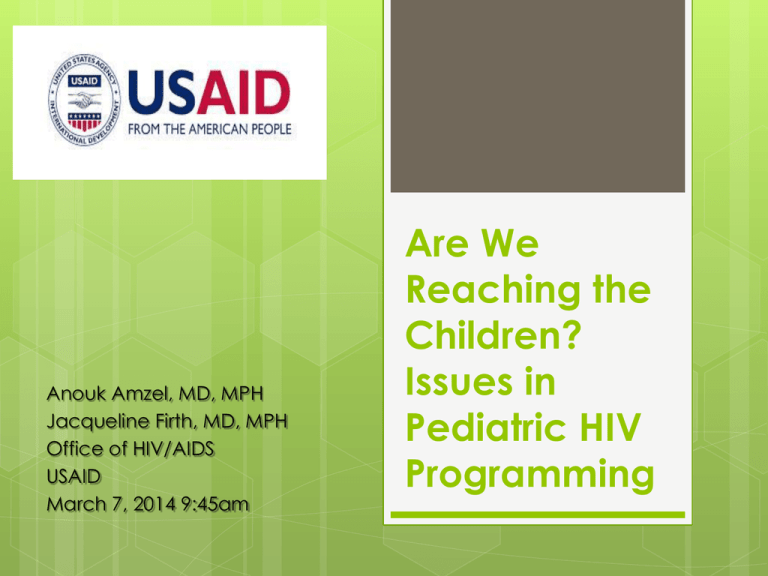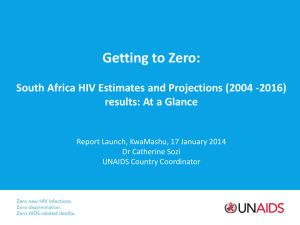
Anouk Amzel, MD, MPH
Jacqueline Firth, MD, MPH
Office of HIV/AIDS
USAID
March 7, 2014 9:45am
Are We
Reaching the
Children?
Issues in
Pediatric HIV
Programming
Outline
Epidemiology
of Pediatric HIV
Perinatal Infection and Implications
Prevention of Infant Infections
How are infant infections different from adult
infections?
Where Can HIV-positive children be found?
Adolescents
Living with HIV
Starting and Keeping Children and Adolescents
LHIV on Treatment
Treatment of Children and Youth with HIV
Retention in Care and Treatment Programs
Epidemiology
Children and HIV
How many new HIV infections occurred among
children (0-14 years) in low- and middle-income
countries in 2012?
260,000
What percentage of HIV-infected children received
ART in 2012?
34%
What percentage of infants living with HIV will die
before their first birthday without treatment?
Before their second birthday?
One-third
Half
“Towards an AIDS-Free Generation: Children and AIDS 6th Stocktaking Report
2013”, UNICEF, Nov. 2013
Where are Children Living with HIV?
The Good News
Prevention of
infant
infections
Timing of MTCT
Overall cumulative risk MTCT
(without antiretroviral drugs): 40-45%
BREASTFEEDING POPULATION
Antenatal
Early
Postpartum
Late
Pregnancy
10-25%
<28 wks
>28 wks
Early
LaborDelivery
35-40%
Late
Breastfeeding
35-40%
0-1 mo
1-6 mos
6-24 mos
Slide courtesy of Lynne Mofenson--
PMTCT Strategies and Timeline
1984
1994
1999
•
1st case
of
pediatric
HIV
infection
reported
•
AZT shown to
decrease
MTCT in the US
Short-course
AZT found to
decrease
MTCT
SdNVP found
to decrease
MTCT
2004
AZT +
sdNVP
endorsed
by WHO
PMTCT
guidelines
2010
2013
Programmatic
considerations
lead WHO to
endorse
options B/B+
WHO
guidelines
recommend
PMTCT
Options A
and B
Translation of Trial Results into Practice
Slide courtesy of Lynne Mofenson
Elimination of MTCT Requires More than Just ARVs
500000
454,000
400000
367,000
300000
--New Perinatal HIV Infections, 25
Countries in the Year 2015
--Virtual Elimination Goal <40,000
Perinatal Infections/Year and <5%
MTCT
138,000
MTCT 11%
200000
95,000
MTCT 11%
100000
0
No
ARVs
for
PMTCT
2009 ARV
coverage
(53%
women
reached)
90% ARV
coverage
Mahy M et al. Sex Trans Infect 2010;86 Suppl 2:ii48-55
--90% ARV
coverage +
--HIV
incidence
women↓ by
50% +
--no unmet
family
planning
72,000
MTCT 8%
--90% ARV
coverage +
--HIV incidence
↓by 50% +
--no unmet
family
planning +
--limit BF to 12
mos
Slide courtesy of Lynne Mofenson
How are
infant
infections
different from
adult
infections?
Timing of Infections-Adults
Infection
Clinical Latency
= HIV virus
= CD4 count
AIDS
Timing of Infection-Pediatrics
Rapid
Median
Progressors Progressors
(10-30%)
(70-85%)
Late
Progressors
(<5%)
• Symptomatic
within 1st year
of life
• Typically
infected in
utero
• Symptomatic in
childhood and
adolescence
• Typically infected
through
breastfeeding
• Symptomatic
within first 5 years
of life
• Typically infected
intra-partum
HIV + Infant and Child Survival without ART
Without ART,
50% of HIV
positive
infants will
die by age 2
Slide modified from K4Health “Module I Intro to Ped HIV Care and Trea
Why does HIV infection progress
faster in Children?
A Theory: Immune system immaturity
Allows
HIV replication in blood
lymphocytes without strong response
Intestinal infection not blocked as
effectively in children because of low
defenses there as well
What about that Mississippi Baby
who was “Cured?”
An unusual case whose treatment is being explored further
The mother --newly infected close to delivery (diagnosed at
delivery—received no ARVs during pregnancy)
Infant-- started on an atypical protocol (triple ARVs at 30 hours of life
after confirmation of HIV infection)
Viral suppression--day of life #21 on HAART
The child was LTFU after 18mo, returned at 23 months of age, off of
ARVs since 18 months of age
No HIV was detected when returned to care, despite the child being
off of ARVs
Experts postulate that the “functional cure” is due to a lack of
development of HIV viral DNA reservoir
D Persaud , et al “Functional HIV Cure after Very Early ART of an Infected Infant” Session 10-Oral Abstracts (Paper #48LB);
NH Tobin and GM Aldrovandi “Are Infants Unique in Their Ability to be “Functionally Cured” of HIV-1?” Current HIV/AIDS
Report Jan 2014
Issues for HIV-exposed but
uninfected infants
Higher
risk of morbidity and mortality in first
few months of life
Neonatal
sepsis, pneumonia, diarrhea
Especially with lower maternal CD4 count/more
severe HIV disease
Higher
weight
rates of preterm delivery, low birth
Worsened with maternal treatment with HAART prenatally
Question
of developmental delay vs. normal
neurodevelopment
(L Kuhn, P Kasonde, M Sinkala, et al.“Does Severity of HIV Disease in HIV-Infected Mothers Affect Mortality and Morbidity among
Their Uninfected Infants?,” Clin Infect Dis. 2005 December 1; 41(11): 1654–1661.)
(Chen JY et al. 19th CROI, Seattle, WA, March 2012 (Abs 1028) )
Where can
HIV-positive
children be
found?
How to find Children with HIV
Screen for HIV exposure at all points of routine contact with
infants and children (i.e. EPI clinics)
Rationale—lots of exposure to young infants (use as a safety net to
capture exposed infants LTFU from PMTCT cascade)
Perform Routine Provider Initiated Testing & Counseling (PITC) in
all areas where sick children are seen (OPD, malnutrition clinics/wards,
TB clinics/wards, in-patient wards)
Rationale—infants and children with HIV who have not been tested
get sick when their immune system wanes
Test high risk populations (children of HIV+ adults in care and
treatment, OVCs, key population youth)
Rationale—these children/youth are high risk based on in-utero
exposure to HIV, possible parental loss due to HIV, or personal high
risk behaviors
Adolescents
What about Adolescents?
How
many new HIV infections occurred among
adolescents (15–19 years) in 2012?
How
300,000
many adolescents (10–19 years) were living
with HIV in 2012?
2.1 million
How
did AIDS-related deaths among adolescents
(10-19 years) change between 2005 and 2012?
Increased by 50%
Where are Adolescents Living With HIV?
Half of adolescents living with HIV
are in six countries
Adolescents
Adolescents
are the only age group in which AIDSrelated deaths have increased
Discrimination, poverty, inequalities, and harsh laws
often prevent adolescents from seeking and
receiving testing, health care and support
Too many children and adolescents die because
they miss out on HIV treatment and care
“Towards an AIDS-Free Generation: Children and AIDS 6th Stocktaking Report
2013”, UNICEF, Nov. 2013
Infections among adolescents are
not slowing fast enough
Adolescent AIDS-related deaths:
the only group where deaths are increasing
Most adolescents don’t know
their HIV status
“Feminization” of HIV starts in the young
Treatment of
children and
youth with HIV
Pediatric ART Coverage Trend
Note: ART coverage from previous years has been recalculated based on new estimates
Source: UNAIDS, Together We Will End AIDS, 2012
Children half as likely as adults
to get the treatment they need
Pediatric ART Coverage by Country
10-19%
20-29%
30-39%
40% and above
Slide courtesy of Eric Dzuiban, CDC
Disparities in Coverage
100%
90%
Adult ART Coverage
Pediatric ART Coverage
80%
70%
60%
50%
40%
30%
20%
10%
0%
Slide courtesy of Eric Dzuiban, CDC
2013 WHO Guidelines-
Pediatric Treatment Recommendations
The new 2013 WHO Guidelines now recommend:
1) When to start HAART in the different ages:
2013 WHO Guidelines-
Pediatric Treatment Recommendations
2) And with what triple drug regimen to start:
For all children less than 3 years of age:
For children and adolescents:
Retention in
care and
treatment
programs
Factors that Negatively Affect Retention
Populations
at high risk for Loss to
Follow Up (LTFU)
Caregiver factors
Health care provider factors
Institutional factors
Interventions that Can Improve
Retention of Children and Youth
Individual
support
Treatment buddies/peer support
Disclosure
Medication/appointment reminders (SMS, phone calls, etc)
Facility-level
interventions
Coordination between staff and services
Integration of services (e.g. family-centered care)
Task-shifting
Community-based
support
Home-based nursing care
Community support groups (including teen clubs)
The Good News
A Few Resources
Adolescent Transition toolkit: http://www.aidstarone.com/sites/default/files/AIDSTAR-One_ALHIV_Toolkit.pdf
Pediatric and Adolescent Disclosure Handbooks:
http://www.aidstarone.com/focus_areas/treatment/resources/pediatric_disclos
ure_materials
WHO Adolescent-Friendly Services:
http://apps.who.int/iris/bitstream/10665/75217/1/97892415035
94_eng.pdf?ua=1;
http://whqlibdoc.who.int/hq/2003/WHO_FCH_CAH_02.14.pdf
?ua=1
2013 WHO Consolidated ARV Guidelines:
http://www.who.int/hiv/pub/guidelines/arv2013/en/
UNICEF Children and AIDS 6th Stocktaking Report:
http://www.childrenandaids.org/files/str6_full_report_29-112013.pdf
Thank you!
Thank you!
Next Session Room Numbers:
Please fill out an
evaluation by going
to this session’s
page on your mobile
app OR by filling out
a paper evaluation
in the back of the
room.
Listen Up: What African MSM Want in the Response to HIV
301
A Practical Way to Maintain Skills Wherever Providers Deliver Babies
302
Establishing an Interactive Education System for Frontline Health Workers
307
Health Finance Food Court: What's Cooking?
308
Shaken, Not Stirred: The Intersection of Alcohol, Gender, and Health
310
A Vaccine's Journey: The Many Steps to Saving Lives
311
Postpartum Family Planning: Bridging Barriers and Motivating Change
405
Combating Counterfeit and Substandard Medicines
407
How Much Will It Cost to Reach Key Populations?
Antenatal Corticosteroid Jeopardy!: Exploring Maternal Interventions for Preterm
Birth
Innovations to an M&E System Improves Data Quality and Speed of Malaria
Prevention Program Results
413
Business Planning for the Rest of Us
Bringing Together Public and Private Sectors for Health Impact
414
Betts Theatre
Continental
Ballroom
Grand
Ballroom







